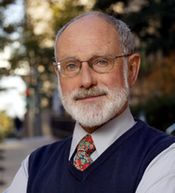Ronald H. Gray
(Dieser Artikel wurde noch nicht aus dem Englischen übersetzt oder enthält noch englische Textpassagen. Bitte beziehe dich vorerst auf die Informationen im englischen Artikel. Klicke dazu in der IntactiWiki-Navigation im Abschnitt "In anderen Sprachen" auf "English".)
Ronald H. Gray is a North American circumcision proponent and biased researcher looking for justifications to roll-out mass circumcision programs around the world. He headed one of the three RCTs being used by the WHO to endorse circumcision as HIV prevention.[1] At their clinic, a music video promoting circumcision plays continuously.[2][3] He sometimes goes by the name Ron.[4]

|
| Ronald H. Gray |
| Married To: |
| Maria Wawer |
| Colleagues & Benefactors: |
| Maria Wawer Robert C. Bailey Bertran Auvert Brian J. Morris Aaron Tobian Thomas Quinn |
| Funded By: |
| Bill & Melinda Gates Foundation Johns Hopkins National Institutes of Health |
 Ronald Gray with his wife, and colleague, Maria Wawer. |
Ronald Gray's RCT
Of the three RCTs being used by the WHO to promote circumcision as HIV prevention, Gray supervised the RCT that was carried out in Uganda.[5] Two other RCTs were supervised by Robert C. Bailey and Bertran Auvert respectively. All three RCTs were funded by the American National Institutes of Health.[6]
In 2010,[7] and again in 2011,[4] Gray published studies with Brian J. Morris.
Zitate
| ” | We've never used surgery to prevent an infectious disease. It's a completely new concept, a new paradigm. How can we train all the surgeons to do this procedure and equip them. – Ronald H. Gray (JohnsHopkinsSPH)[8] |
| ” | It's been hard to change policy, because this is a whole new paradigm. We've never used surgery to prevent an infectious disease. Policy makers have to really take some time to wrap their minds around it. – Ronald H. Gray (JohnsHopkinsSPH)[9] |
| ” | It's taken longer than I would like to see these programs emerge. – Ronald H. Gray (JohnsHopkinsSPH)[10] |
| ” | The Latest Fight Over Foreskin If you were to ask me, should the U.S. be promoting circumcision, my answer would be, ‘no,’ What I do think ought to be the policy is that parents should be informed about the potential protective effects. – Ronald H. Gray (N.Y. Times)[11] |
Einzelnachweise
- ↑ World Health Organization.
Information Package on Male Circumcision and HIV Prevention
. Abgerufen 7. Mai 2011. - ↑ JohnsHopkinsSPH (1. Oktober 2010).
Rakai Project
. Abgerufen 10. April 2011. - ↑ smugamba (6. Juni 2010).
Rakai Male Circumcision Video By Stephen Mugamba Feat Jemima Sanyu.mpg
. Abgerufen 10. April 2011. - ↑ a b Morris, Brian J., Gray, Ronald H., Castellsagué, Xavier, Bosch, F. Xavier, Halperin, Daniel T., Hankins, C.A., Waskett, Jake H.. The Strong Protective Effect of Circumcision Against Cancer of the Penis. Advanced in Urology. 9. März 2011; Abgerufen am 13. März 2011.
- ↑ Gray, R.H., Kigozi, G., Serwadda, D., et al. Male circumcision for HIV prevention in men in Rakai, Uganda: a randomised trial. Lancet. 369: 557-566.
- ↑ (2008).
The Use of Male Circumcision to Prevent HIV Infection
, Doctors Opposing Circumcision. Abgerufen 5. März 2011.
Zitat:...funding from the United States National Institutes of Health to conduct randomized controlled trials (RCTs) in Africa.
- ↑ Gray, R.H., Bailey, R.C., Morris, B.J.. Keratinization of the adult male foreskin and implications for male circumcision. AIDS. 1. Juni 2010; 24(9): 1381; author reply 1381–2. PMID. DOI.
- ↑ JohnsHopkinsSPH, (2009). Impact.
- ↑ JohnsHopkinsSPH, (2010). Rakai project.
- ↑ JohnsHopkinsSPH, (2010). Rakai project.
- ↑ N.Y. Times, The Latest Fight Over Foreskin, (8/29/2009).